2019 DODGE CHARGER SRT check engine light
[x] Cancel search: check engine lightPage 189 of 496
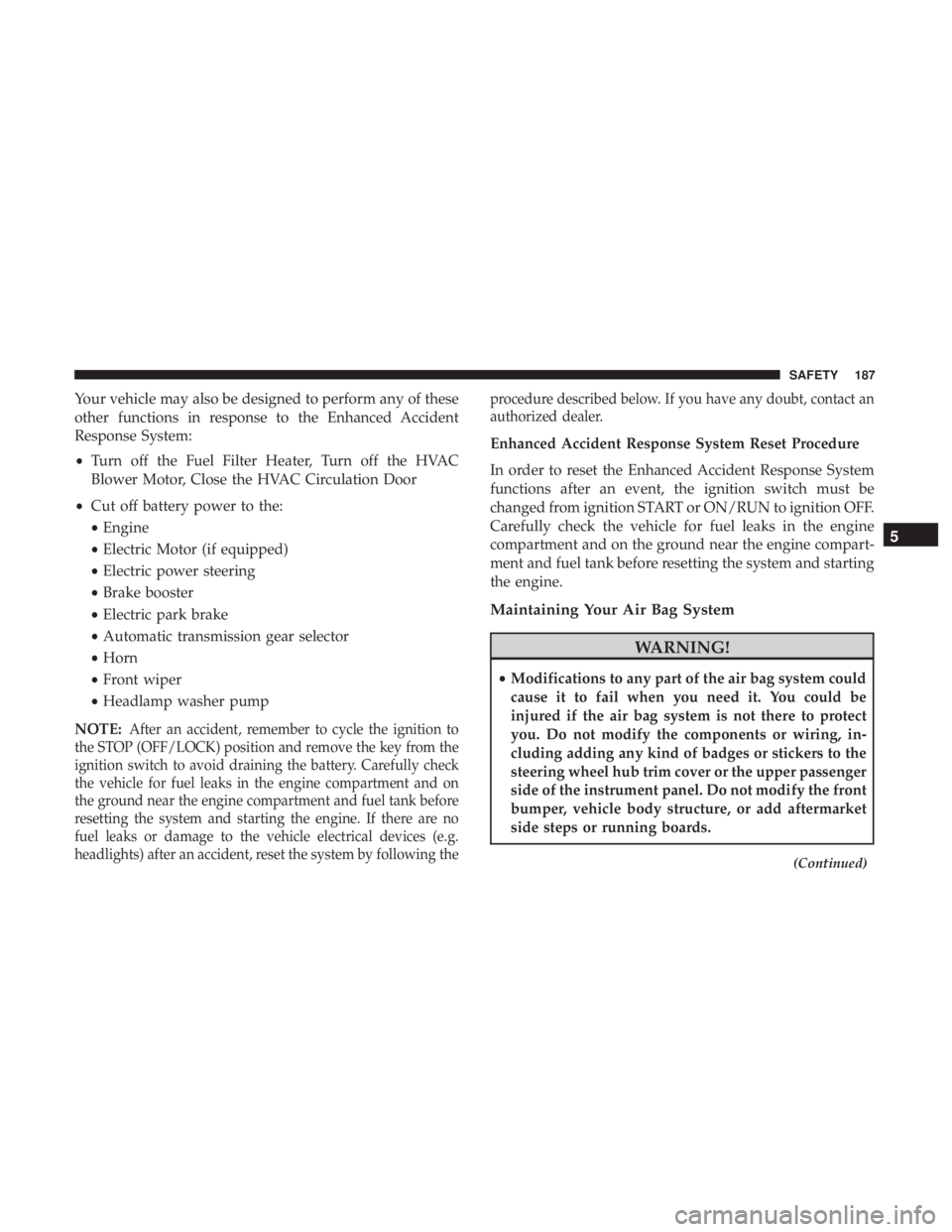
Your vehicle may also be designed to perform any of these
other functions in response to the Enhanced Accident
Response System:
•Turn off the Fuel Filter Heater, Turn off the HVAC
Blower Motor, Close the HVAC Circulation Door
• Cut off battery power to the:
• Engine
• Electric Motor (if equipped)
• Electric power steering
• Brake booster
• Electric park brake
• Automatic transmission gear selector
• Horn
• Front wiper
• Headlamp washer pump
NOTE:
After an accident, remember to cycle the ignition to
the STOP (OFF/LOCK) position and remove the key from the
ignition switch to avoid draining the battery. Carefully check
the vehicle for fuel leaks in the engine compartment and on
the ground near the engine compartment and fuel tank before
resetting the system and starting the engine. If there are no
fuel leaks or damage to the vehicle electrical devices (e.g.
headlights) after an accident, reset the system by following the procedure described below. If you have any doubt, contact an
authorized dealer.
Enhanced Accident Response System Reset Procedure
In order to reset the Enhanced Accident Response System
functions after an event, the ignition switch must be
changed from ignition START or ON/RUN to ignition OFF.
Carefully check the vehicle for fuel leaks in the engine
compartment and on the ground near the engine compart-
ment and fuel tank before resetting the system and starting
the engine.
Maintaining Your Air Bag System
WARNING!
•
Modifications to any part of the air bag system could
cause it to fail when you need it. You could be
injured if the air bag system is not there to protect
you. Do not modify the components or wiring, in-
cluding adding any kind of badges or stickers to the
steering wheel hub trim cover or the upper passenger
side of the instrument panel. Do not modify the front
bumper, vehicle body structure, or add aftermarket
side steps or running boards.
(Continued)
5
SAFETY 187
Page 207 of 496
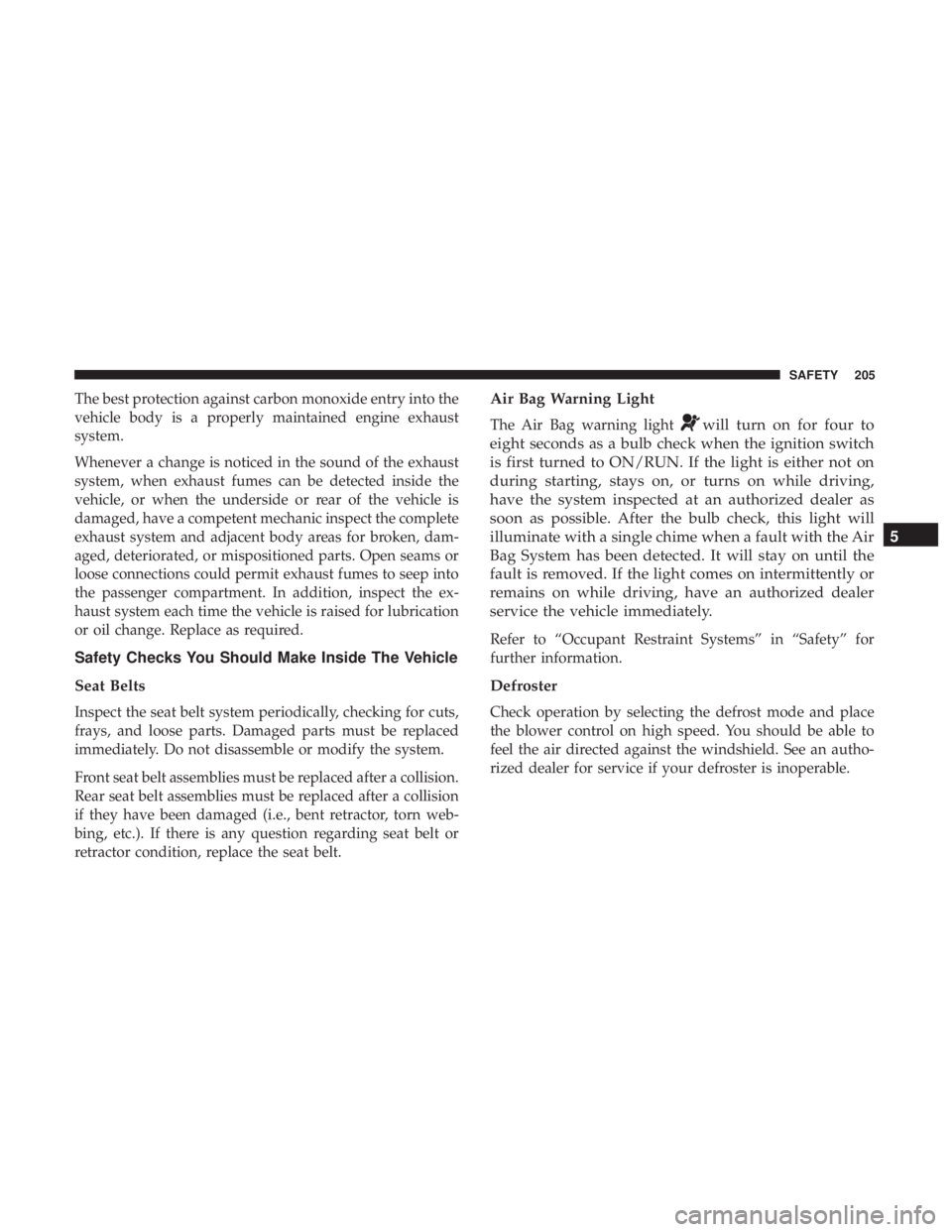
The best protection against carbon monoxide entry into the
vehicle body is a properly maintained engine exhaust
system.
Whenever a change is noticed in the sound of the exhaust
system, when exhaust fumes can be detected inside the
vehicle, or when the underside or rear of the vehicle is
damaged, have a competent mechanic inspect the complete
exhaust system and adjacent body areas for broken, dam-
aged, deteriorated, or mispositioned parts. Open seams or
loose connections could permit exhaust fumes to seep into
the passenger compartment. In addition, inspect the ex-
haust system each time the vehicle is raised for lubrication
or oil change. Replace as required.
Safety Checks You Should Make Inside The Vehicle
Seat Belts
Inspect the seat belt system periodically, checking for cuts,
frays, and loose parts. Damaged parts must be replaced
immediately. Do not disassemble or modify the system.
Front seat belt assemblies must be replaced after a collision.
Rear seat belt assemblies must be replaced after a collision
if they have been damaged (i.e., bent retractor, torn web-
bing, etc.). If there is any question regarding seat belt or
retractor condition, replace the seat belt.
Air Bag Warning Light
The Air Bag warning lightwill turn on for four to
eight seconds as a bulb check when the ignition switch
is first turned to ON/RUN. If the light is either not on
during starting, stays on, or turns on while driving,
have the system inspected at an authorized dealer as
soon as possible. After the bulb check, this light will
illuminate with a single chime when a fault with the Air
Bag System has been detected. It will stay on until the
fault is removed. If the light comes on intermittently or
remains on while driving, have an authorized dealer
service the vehicle immediately.
Refer to “Occupant Restraint Systems” in “Safety” for
further information.
Defroster
Check operation by selecting the defrost mode and place
the blower control on high speed. You should be able to
feel the air directed against the windshield. See an autho-
rized dealer for service if your defroster is inoperable.
5
SAFETY 205
Page 208 of 496
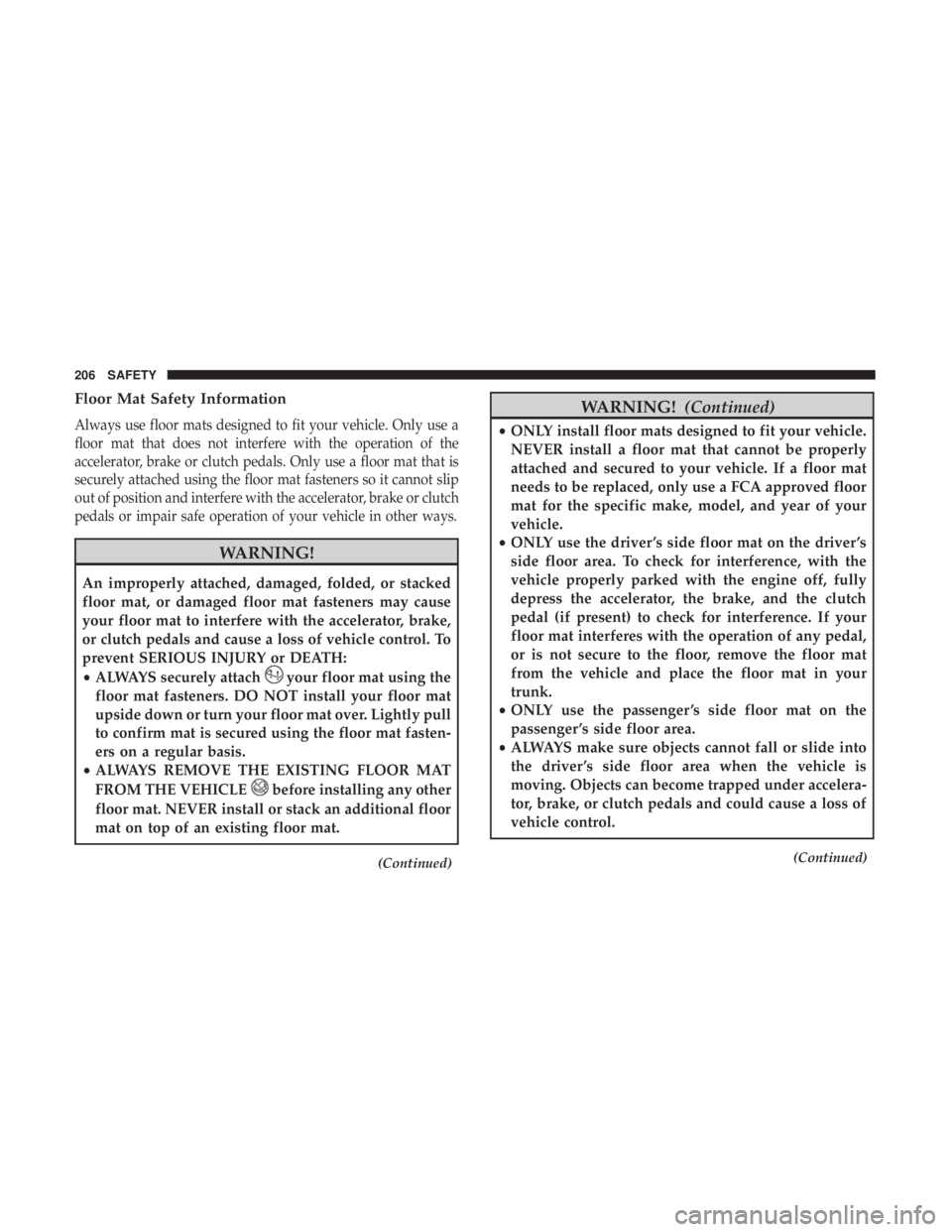
Floor Mat Safety Information
Always use floor mats designed to fit your vehicle. Only use a
floor mat that does not interfere with the operation of the
accelerator, brake or clutch pedals. Only use a floor mat that is
securely attached using the floor mat fasteners so it cannot slip
out of position and interfere with the accelerator, brake or clutch
pedals or impair safe operation of your vehicle in other ways.
WARNING!
An improperly attached, damaged, folded, or stacked
floor mat, or damaged floor mat fasteners may cause
your floor mat to interfere with the accelerator, brake,
or clutch pedals and cause a loss of vehicle control. To
prevent SERIOUS INJURY or DEATH:
•ALWAYS securely attach
your floor mat using the
floor mat fasteners. DO NOT install your floor mat
upside down or turn your floor mat over. Lightly pull
to confirm mat is secured using the floor mat fasten-
ers on a regular basis.
• ALWAYS REMOVE THE EXISTING FLOOR MAT
FROM THE VEHICLE
before installing any other
floor mat. NEVER install or stack an additional floor
mat on top of an existing floor mat.
(Continued)
WARNING! (Continued)
•ONLY install floor mats designed to fit your vehicle.
NEVER install a floor mat that cannot be properly
attached and secured to your vehicle. If a floor mat
needs to be replaced, only use a FCA approved floor
mat for the specific make, model, and year of your
vehicle.
• ONLY use the driver ’s side floor mat on the driver ’s
side floor area. To check for interference, with the
vehicle properly parked with the engine off, fully
depress the accelerator, the brake, and the clutch
pedal (if present) to check for interference. If your
floor mat interferes with the operation of any pedal,
or is not secure to the floor, remove the floor mat
from the vehicle and place the floor mat in your
trunk.
• ONLY use the passenger ’s side floor mat on the
passenger ’s side floor area.
• ALWAYS make sure objects cannot fall or slide into
the driver ’s side floor area when the vehicle is
moving. Objects can become trapped under accelera-
tor, brake, or clutch pedals and could cause a loss of
vehicle control.
(Continued)
206 SAFETY
Page 332 of 496
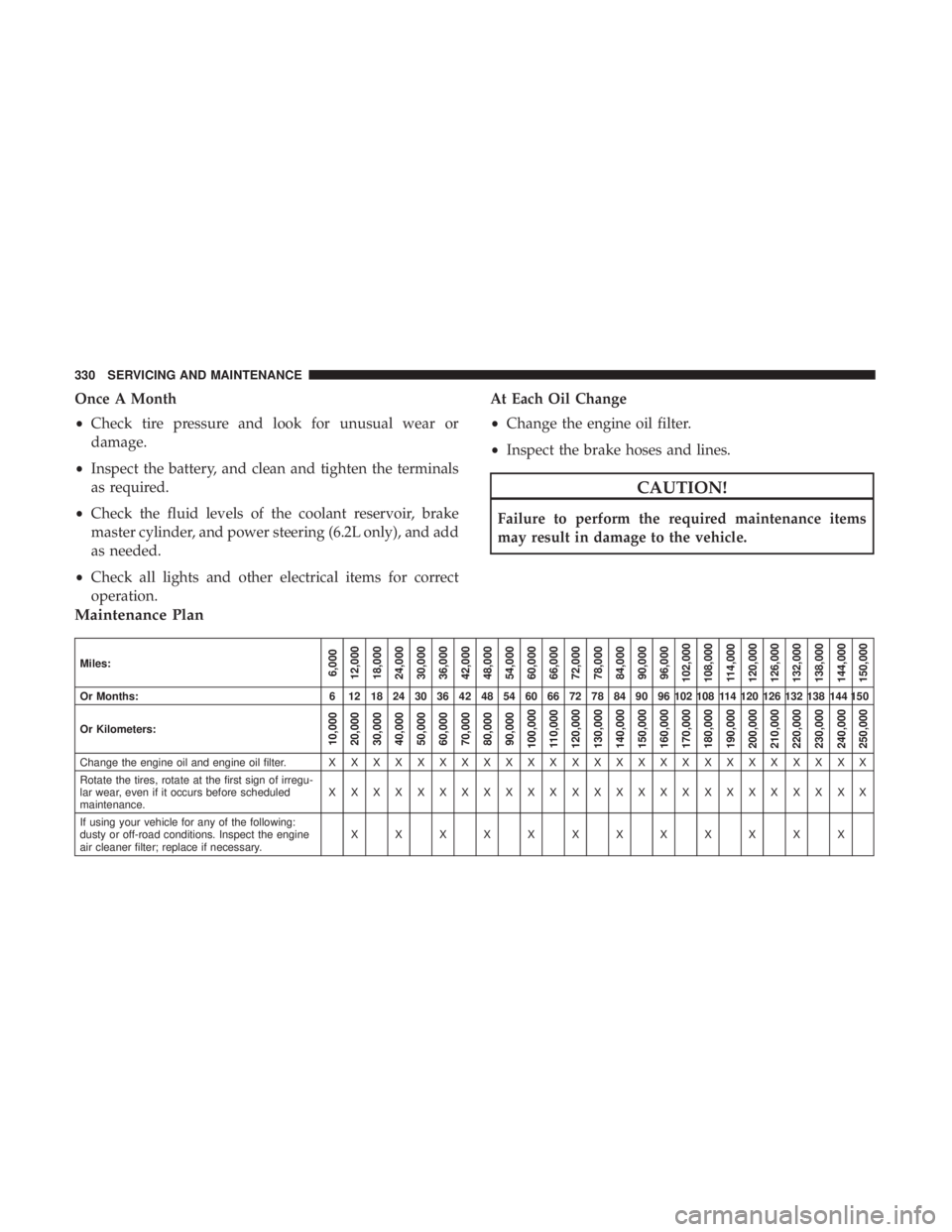
Once A Month
•Check tire pressure and look for unusual wear or
damage.
• Inspect the battery, and clean and tighten the terminals
as required.
• Check the fluid levels of the coolant reservoir, brake
master cylinder, and power steering (6.2L only), and add
as needed.
• Check all lights and other electrical items for correct
operation. At Each Oil Change
•
Change the engine oil filter.
• Inspect the brake hoses and lines.
CAUTION!
Failure to perform the required maintenance items
may result in damage to the vehicle.
Maintenance Plan
Miles:6,000
12,000
18,000
24,000
30,000
36,000
42,000
48,000
54,000
60,000
66,000
72,000
78,000
84,000
90,000
96,000
102,000
108,000 114,000
120,000
126,000
132,000
138,000
144,000
150,000
Or Months: 6 12 18 24 30 36 42 48 54 60 66 72 78 84 90 96 102 108 114 120 126 132 138 144 150
Or Kilometers:
10,000
20,000
30,000
40,000
50,000
60,000
70,000
80,000
90,000
100,000
110,000
120,000
130,000
140,000
150,000
160,000
170,000
180,000
190,000
200,000
210,000
220,000
230,000
240,000
250,000
Change the engine oil and engine oil filter. X X XXXXXXXXXXXXXXXXXXXXXXX
Rotate the tires, rotate at the first sign of irregu-
lar wear, even if it occurs before scheduled
maintenance. XXXXXXXXXXXXXXXXXXXXXXXXX
If using your vehicle for any of the following:
dusty or off-road conditions. Inspect the engine
air cleaner filter; replace if necessary. XXXXXXXXXXXX
330 SERVICING AND MAINTENANCE
Page 451 of 496
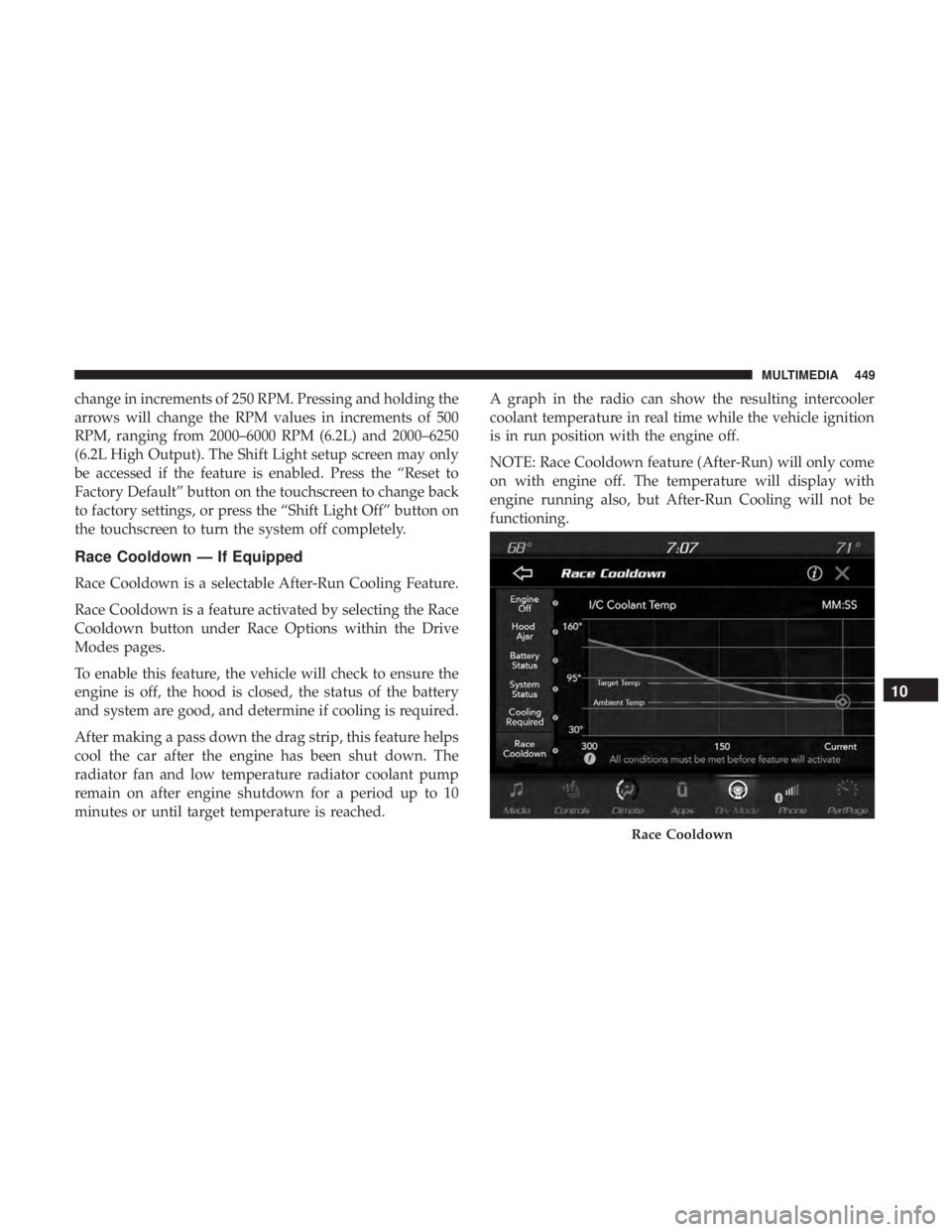
change in increments of 250 RPM. Pressing and holding the
arrows will change the RPM values in increments of 500
RPM, ranging from 2000–6000 RPM (6.2L) and 2000–6250
(6.2L High Output). The Shift Light setup screen may only
be accessed if the feature is enabled. Press the “Reset to
Factory Default” button on the touchscreen to change back
to factory settings, or press the “Shift Light Off” button on
the touchscreen to turn the system off completely.
Race Cooldown — If Equipped
Race Cooldown is a selectable After-Run Cooling Feature.
Race Cooldown is a feature activated by selecting the Race
Cooldown button under Race Options within the Drive
Modes pages.
To enable this feature, the vehicle will check to ensure the
engine is off, the hood is closed, the status of the battery
and system are good, and determine if cooling is required.
After making a pass down the drag strip, this feature helps
cool the car after the engine has been shut down. The
radiator fan and low temperature radiator coolant pump
remain on after engine shutdown for a period up to 10
minutes or until target temperature is reached.A graph in the radio can show the resulting intercooler
coolant temperature in real time while the vehicle ignition
is in run position with the engine off.
NOTE: Race Cooldown feature (After-Run) will only come
on with engine off. The temperature will display with
engine running also, but After-Run Cooling will not be
functioning.
Race Cooldown
10
MULTIMEDIA 449
Page 482 of 496
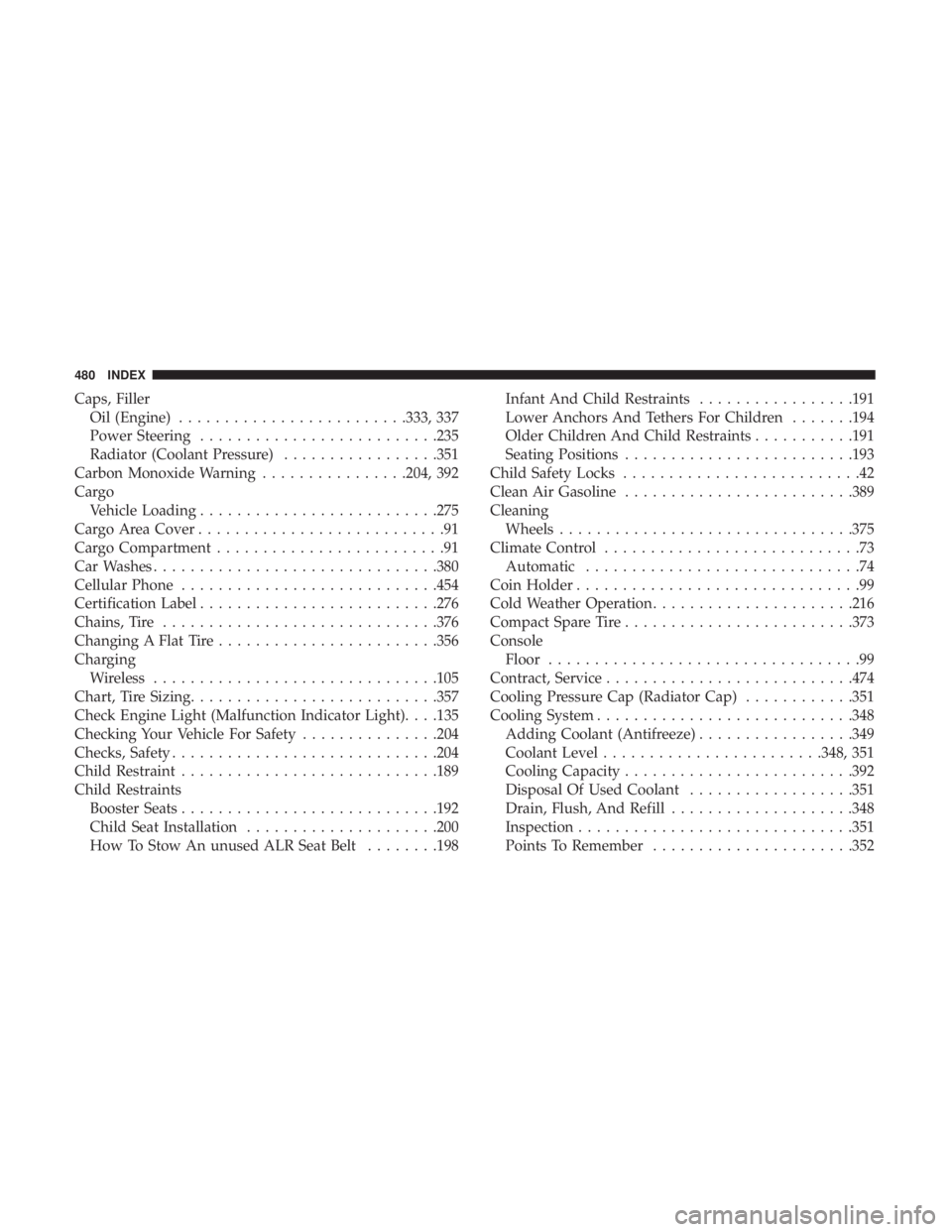
Caps, FillerOil (Engine) ........................ .333, 337
Power Steering ......................... .235
Radiator (Coolant Pressure) .................351
Carbon Monoxide Warning ................204, 392
Cargo Vehicle Loading ......................... .275
Cargo Area Cover ...........................91
Cargo Compartment .........................91
Car Washes .............................. .380
Cellular Phone ........................... .454
Certification Label ......................... .276
Chains, Tire ............................. .376
Changing A Flat Tire ....................... .356
Charging Wireless .............................. .105
Chart, Tire Sizing .......................... .357
Check Engine Light (Malfunction Indicator Light). . . .135
Checking Your Vehicle For Safety ...............204
Checks, Safety ............................ .204
Child Restraint ........................... .189
Child Restraints Booster Seats ........................... .192
Child Seat Installation .....................200
How To Stow An unused ALR Seat Belt ........198Infant And Child Restraints
.................191
Lower Anchors And Tethers For Children .......194
Older Children And Child Restraints ...........191
Seating Positions ........................ .193
Child Safety Locks ..........................42
Clean Air Gasoline ........................ .389
Cleaning Wheels ............................... .375
Climate Control ............................73
Automatic ..............................74
Coin Holder ...............................99
Cold Weather Operation ..................... .216
Compact Spare Tire ........................ .373
Console Floor ..................................99
Contract, Service .......................... .474
Cooling
Pressure Cap (Radiator Cap) ............351
Cooling System ........................... .348
Adding Coolant (Antifreeze) .................349
Coolant Level ....................... .348, 351
Cooling Capacity ........................ .392
Disposal Of Used Coolant ..................351
Drain, Flush, And Refill ....................348
Inspection ............................. .351
Points To Remember ..................... .352
480 INDEX
Page 484 of 496
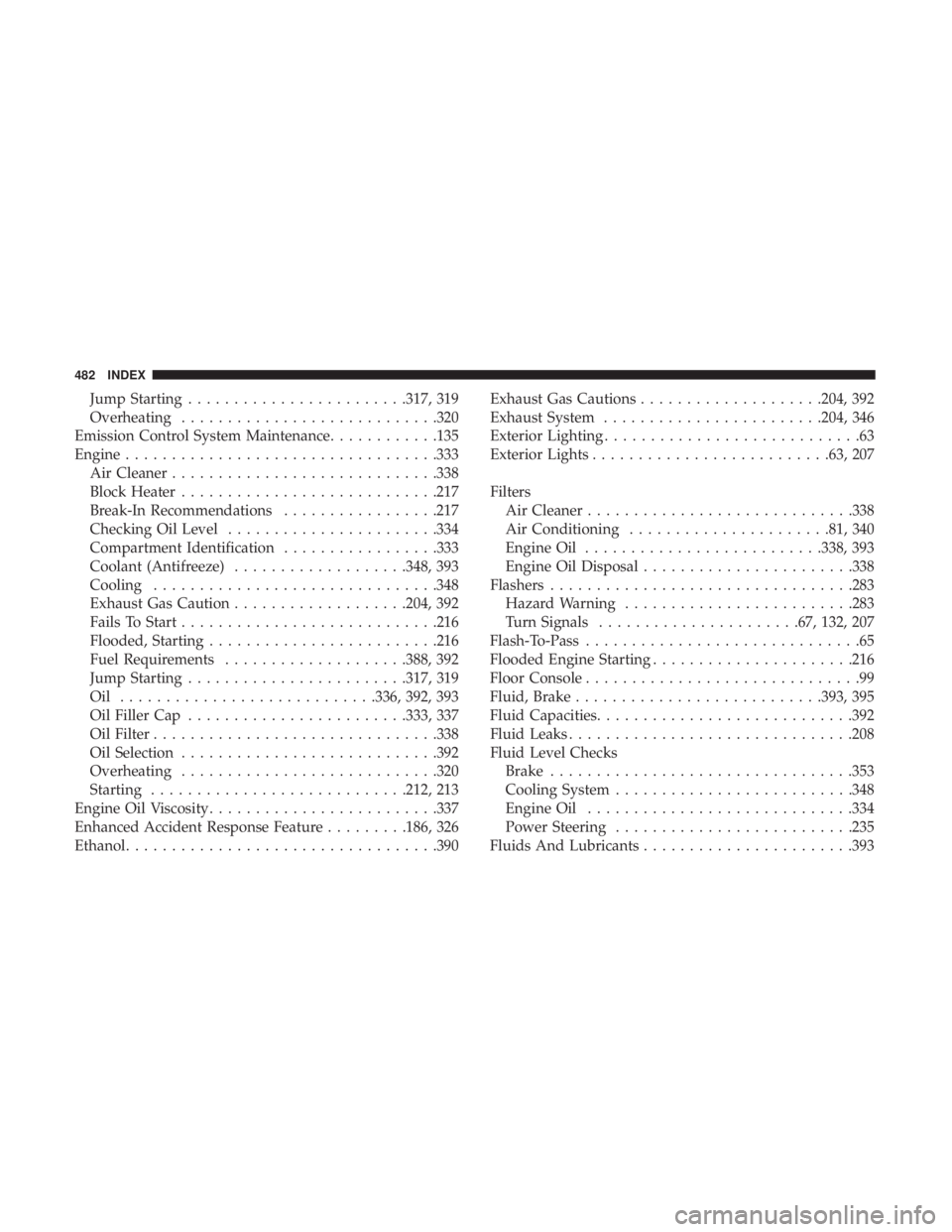
Jump Starting....................... .317, 319
Overheating ........................... .320
Emission Control System Maintenance ............135
Engine ................................. .333
Air Cleaner ............................ .338
Block Heater ........................... .217
Break-In Recommendations .................217
Checking Oil Level ...................... .334
Compartment Identification .................333
Coolant (Antifreeze) ...................348, 393
Cooling .............................. .348
Exhaust Gas Caution ...................204, 392
Fails To Start ........................... .216
Flooded, Starting ........................ .216
Fuel Requirements ....................388, 392
Jump Starting ....................... .317, 319
Oil ........................... .336, 392, 393
Oil Filler Cap ....................... .333, 337
Oil Filter .............................. .338
Oil Selection ........................... .392
Overheating ........................... .320
Starting ........................... .212, 213
Engine Oil Viscosity ........................ .337
Enhanced Accident Response Feature .........186, 326
Ethanol ................................. .390Exhaust Gas Cautions
....................204, 392
Exhaust System ....................... .204, 346
Exterior Lighting ............................63
Exterior Lights ......................... .63, 207
Filters Air Cleaner ............................ .338
Air Conditioning ..................... .81, 340
Engine Oil ......................... .338, 393
Engine Oil Disposal ...................... .338
Flashers ................................ .283
Hazard Warning ........................ .283
T
urn Signals ..................... .67, 132, 207
Flash-To-Pass ..............................65
Flooded Engine Starting ..................... .216
Floor Console ..............................99
Fluid, Brake .......................... .393, 395
Fluid Capacities ........................... .392
Fluid Leaks .............................. .208
Fluid Level Checks Brake ................................ .353
Cooling System ......................... .348
Engine Oil ............................ .334
Power Steering ......................... .235
Fluids And Lubricants ...................... .393
482 INDEX
Page 487 of 496
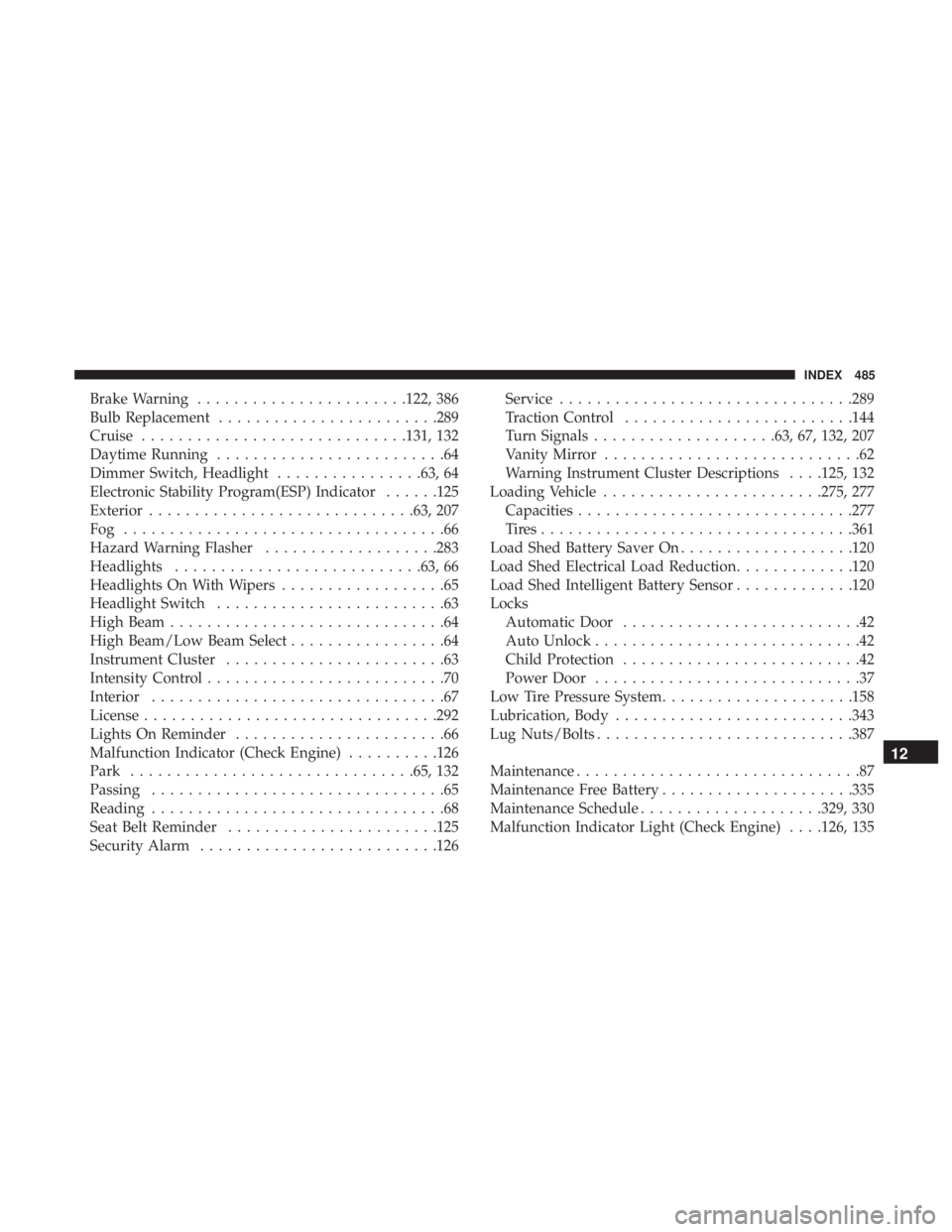
Brake Warning...................... .122, 386
Bulb Replacement ....................... .289
Cruise ............................ .131, 132
Daytime Running .........................64
Dimmer Switch, Headlight ................63, 64
Electronic Stability Program(ESP) Indicator ......125
Exterior ............................ .63, 207
Fog ...................................66
Hazard Warning Flasher ...................283
Headlights .......................... .63, 66
Headlights On With Wipers ..................65
Headlight Switch .........................63
High Beam ..............................64
High Beam/Low Beam Select .................64
Instrument Cluster ........................63
Intensity Control ..........................70
Interior ................................67
License ............................... .292
Lights On Reminder .......................66
Malfunction Indicator (Check Engine) ..........126
Park .............................. .65, 132
Passing ................................65
Reading ................................68
Seat Belt Reminder ...................... .125
Security Alarm ......................... .126Service
............................... .289
Traction Control ........................ .144
Turn Signals ....................63, 67, 132, 207
Vanity Mirror ............................62
Warning Instrument Cluster Descriptions . . . .125, 132
Loading Vehicle ....................... .275, 277
Capacities ............................. .277
Tires................................. .361
Load Shed Battery Saver On ...................120
Load Shed Electrical Load Reduction .............120
Load Shed Intelligent Battery Sensor .............120
Locks Automatic Door ..........................42
Auto Unlock .............................42
Child Protection ..........................42
Power Door .............................37
Low Tire Pressure System .....................158
Lubrication,
Body ......................... .343
Lug Nuts/Bolts ........................... .387
Maintenance ...............................87
Maintenance Free Battery .....................335
Maintenance Schedule ....................329, 330
Malfunction Indicator Light (Check Engine) . . . .126, 135
12
INDEX 485